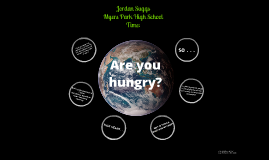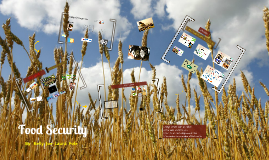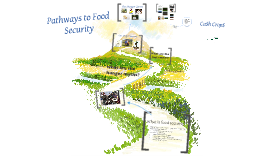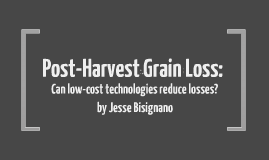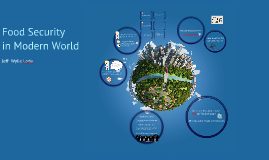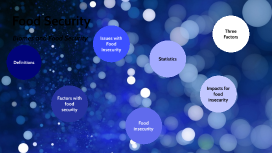Food Security
Transcript: 76% Mineral Scarcity Climate Change Minimal, materials usually available locally Drying (ii) losses would be enough to feed about 70-100 million people, i.e. about 1/3rd of India’s poor. Tarpaulins Platform Dryers Low-cost Solar Dryers Can be constructed of locally available materials by farmers 4% Increase the efficiency of the food system at every level of production, distribution, and consumption. Can low-cost technologies reduce losses? Can be made air and water tight Stimulate off-farm employment Sub-Saharan Africa: Lack of reliable data Difficult to determine the stage of production at which losses occurs Context specific (crop, season, climate, production method, etc.) Rice Losses: Southeast Asia: 10-37% Ghana: 11-18% Maize Losses: Swaziland: 16% lost during wet season Zimbabwe: 14-16% 10% of total poduction Storage Meeting Demand for Food Storage-Related PHL The Global Context: Mud Silos Metal Silos Triple-Bag Technique Hermetic "Super Bags" Decrease the amount of waste produced by the food system at every level of production, distribution, and consumption. 10% Textile Producers in Developing Countries 5% 200 kg silo - $50 1000 kg silo - $150 Lifetime: 10+ years Drying-Related PHL A social enterprise that sells fashionable reuseable bags. For every bag that is sold, we give away a second hermetic "Super Bag" to a farmer somewhere in the developing world for bags: "One for one" Consumer bags are printed with designs by up and coming artists All consumer bag production is responsibly sourced to developing countries, reducing costs and creating off-farm employment opportunities Costs: 2ndSac production: $4/bag Hermetic bag purchases: $2/bag Total costs: $6 SecondSack retail: $8-10/bag Profit: $2-4/bag Hermetic bags are distributed through extension programmes being run by NGO partners like the Bill and Melinda Gates Foundation The Quadruple Bottom Line: Off-farm employment Reduced crop loss Environmentally friendly Profitable The Triple Crisis $1.80 for 50 kg bag, Lifetime: 3-4 years Post-Harvest Grain Loss: $9.99 at Ecobags.com (ii) equates to the annual value of cereal imports of SSA, which had an annual range of between US$3–7 billion over the 2000–07 period. Not Lost (iii) enough to feed the entire population of the states of Bihar and Haryana together for about one year. 2% $4 Billion a year Less than $20 PHL is a urgent issue that needs to be address, especially in the context of increasing mineral resource scarcity, climate change, and population growth Small reductions in the percentage of overall losses could save enough food to feed millions of people Effective, low-cost solutions that can reduce losses already exist More resources must be dedicated to proliferating these technologies Ensuring farmer uptake of technology requires time: extension programs must be designed as medium-long term projects Social entrepreneurship may be capable of engaging with PHL to raise awareness and resources The Problem: Low-Cost Technologies That Improve Drying Can eliminate losses Safely stores grain with 35% MC 10-1000kg capacities Post-Harvest Rice Losses in Southeast Asia $1-2 Lifetime: 6+ seasons Threshing Can be air and water tight, can be used in combination with other storage techniques Transport Improve drying during unfavorable climatic conditions Conclusion 3% Harvesting $15+ 2ndSac Post-Harvest Loss (PHL) (i) equivalent to the total food grains produced in Australia annually Customers Drying (i) exceeds the value of total food aid SSA received over the last decade. Low-Cost Technologies That Improve Storage Fewer mineral inputs. Greater climatic variability. More people to feed. If crops are not dried sufficiently, they may sprout or rot during storage (<12.5% MC) If climatic conditions are not favorable during the drying period, insufficient drying can increase PHL during storage High-yielding varieties often require long drying times, and have led to the introduction of additional cropping seasons, which often necessitate drying during unfavorably wet condition Climate change threatens to alter conditions during the drying period. This could increase humidity and rain, exacerbating drying-related PHL Sun drying crops on the bare ground can lead to pest, dirt, and fungal contamination 2ndSac Handling Harvesting by Jesse Bisignano SecondSack is a social enterprise that sells fashionable reusable bags. For every bag that we sell, we give a hermetic bag to a farmer somewhere in the developing world for bags All reusable bags are designed by up and coming designers All reusable bag production is responsibly sourced to developing countries, creating off-farm employment opportunities Costs: Produce reusable bags for $1 Purchase hermetic bag for $2 Total costs: $3 Sell reusable bags for $5 Profit: $2 per bag Hermetic bags are distributed through partnerships with existing NGO extension programs (Bill and Melinda Gates Foundation) Reduce dirt, pest, and fungal contamination during sun drying Post-Harvest






